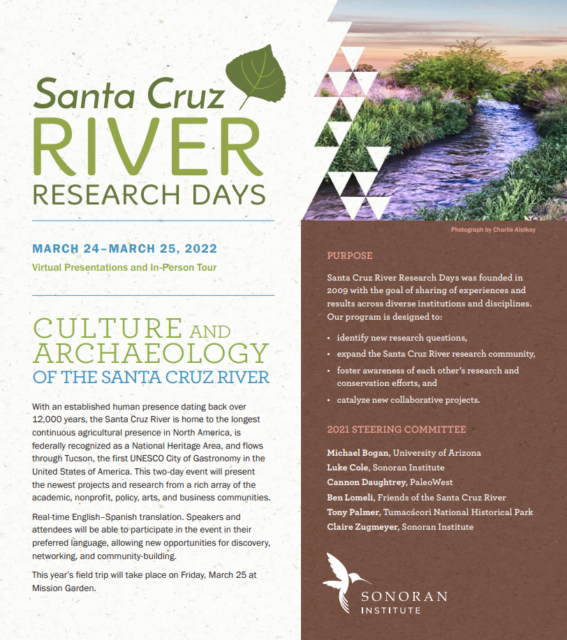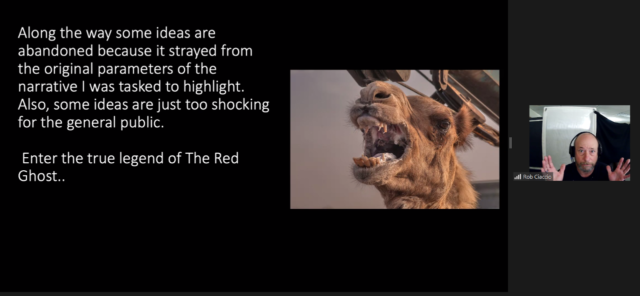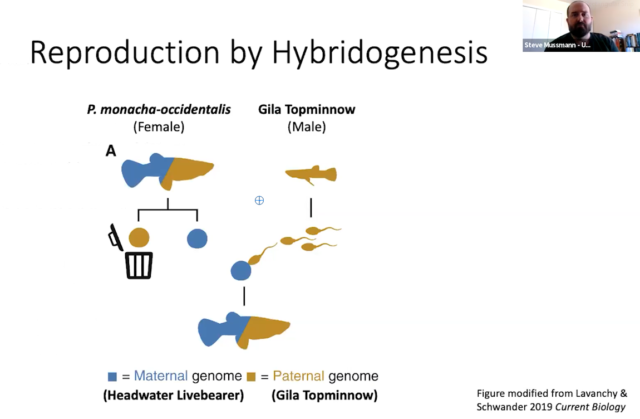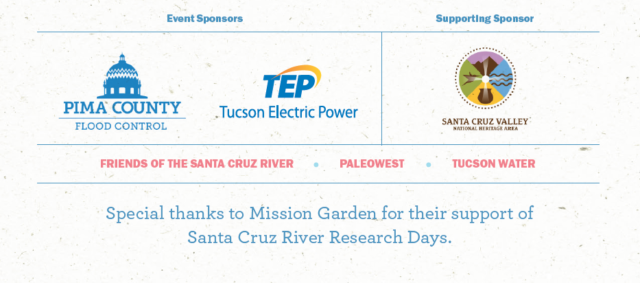“The cultural history of the Santa Cruz is a rich, complex, and fascinating one. For starters, the Santa Cruz is the reason we can call Tucson home. And its waters have supported people and settlements along the river for over 12,000 years.”
 Santa Cruz River Research Days brings together scientists, community leaders, students, and officials from local, state, and federal government agencies. For more than 12 years, the conference has provided a venue to share research findings that impact the lives of residents and wildlife along the Santa Cruz River from Mexico to Marana. Our two-day conference is conducted simultaneously in English and Spanish. This year, we added an in-person field trip to Mission Garden at the base of “A” Mountain.
Santa Cruz River Research Days brings together scientists, community leaders, students, and officials from local, state, and federal government agencies. For more than 12 years, the conference has provided a venue to share research findings that impact the lives of residents and wildlife along the Santa Cruz River from Mexico to Marana. Our two-day conference is conducted simultaneously in English and Spanish. This year, we added an in-person field trip to Mission Garden at the base of “A” Mountain.

The emphasis for this year’s Research Days was the Culture and Archaeology of the Santa Cruz River, though we also had scientists discuss the ecology and hydrology of the Santa Cruz, artists delve into the art that springs from drought and pollution, and engineers present on projects that will get the Santa Cruz running. Archaeologists guided us on a tour of how people lived in this area for millennia and folks like Sonoran Institute’s Luke Cole and Claire Zugmeyer shed light on how people currently living along the river can plan for the future.
Archaeology and Culture
In celebrating the culture of the Santa Cruz River, past and present, Sonoran Institute welcomed two keynote speakers to kick off each day of the symposium. Visual artist and archeologist Robert B. Ciaccio with Desert Archaeology Inc. took us through how groups of ancient peoples lived on this land and even discussed the legend of the infamous Red Ghost. Jesús M. Garcia with Arizona-Sonoran Desert Museum gave us a tour of the ethnobotanical history of Tucson while sharing his personal connection with the Sonoran Desert and the fruits and vegetables that grow naturally in the area.

Hydrology and engineering
Mark Murphy with NV5 and Evan Canfield with Pima County Regional Flood Control District (PCRFCD) discussed the ways the water, ecosystem, and water chemistry are connected and interact within the El Corazón reach of the Santa Cruz River—and how it relies upon these interactions to maintain the existing uses of the stream. Evan Canfield with PCRFCD and Scott Altherr with CMG Drainage Engineering tapped into the three projects and improvements they have been working on in the Santa Cruz River downstream of the Agua Nueva Wastewater Reclamation Facility. Kevin Payne and Rebeca Field, both with Kimley-Horn, focused on the how the restoration of the Corazón Reach has improved the habitats of native and migratory species and how these projects have driven people to enjoy and explore the river once again.
Lauren Monheim with Watershed Management Group discussed their Flow365 Community Science Program, an effort to monitor more continuous data on the river and measure the successes in recovering seasonal and perennial flow of its streams with groundwater recovery efforts. Keeping the Santa Cruz flowing takes engineers, scientists, non-profits, and citizens working together for a healthy river.
Ecology
The river hosts a wide variety of flora and fauna that have thrived in the decade since Pima County upgraded their wastewater treatment facilities. Michael Bogan, Pablo Rocha, and Nikhil Nayhee from the University of Arizona’s School of Natural Resources and the Environment spoke about the aquatic invertebrates like dragonflies and beetles that have recolonized areas of the Santa Cruz, the diversity and density of birds in areas flowing with effluent, the reintroduction of a species of fish long gone from the Tucson section of the Santa Cruz, and how trail cameras have helped emphasize the importance of a healthy riparian corridor.

Steven M. Mussmann with the U.S. Fish and Wildlife Service talked about a genetic study that revealed the presence of a new fish species, Poeciliopsis monacha-occidentalis, which means a non-native/exotic species from Mexico (P. monacha) is now in our river and has hybridized with Gila topminnow (P. occidentalis). We also got to map and follow the bobcat population in Tucson with Cheryl Mollohan from the Bobcats in Tucson Project.
Education and Outreach
Liz Petterson and Bailey Kennett with Arizona Land and Water Trust spoke on how the Sopori Creek and Farm works in the nexus of watershed management, responsible agriculture, and climate change preparedness through their apprenticeship programs. Steve Anderson with Pima County Natural Resources Parks and Recreation celebrated the opening of the Adamson-Catino trail in Green Valley and the creation of the 1.7-mile bike trail and its successful fundraising and crowd rallying!
Human Impact
Matt Robinson with the D.C. Department of Energy & Environment talked about the District’s focus on trash removal from waterways in the nation’s capital and its implementation of green infrastructure such as stormwater harvesting, trash pick-up, and catchments in outflows, to implementation of policies and fees on unnecessary single-use plastics. Luke Cole with the Sonoran Institute and Eleonora Demaria with Pima County Regional Flood Control District discussed how Tucson tracks and tackles trash by organizing volunteer lead trash clean-ups, measuring metrics concerning trash spread, volume, and categories of trash. Finally, we see how artists like Lee Ann Woolery the founder of Citizen Artist™ can take something as dismal as the frequent and necessary trash removal and redirect this to tangible and evocative art that encourages citizen scientists and artists alike to make the world a cleaner and more beautiful place.
Overall, this two-day event was a wealth of information and celebration of our beloved Santa Cruz River! We cannot wait until next year to see what folks bring to highlight their interest and adoration of the river. Santa Cruz River Research Days is part of Sonoran Institute’s Santa Cruz River program. Our focus is to invest in water for the environment and communities along the Santa Cruz River. Our goal for the Santa Cruz is to retain flowing reaches and restore conditions throughout the watershed. We envision a future where a revitalized river corridor is an integral part of our community that strengthens our local economy and reconnects residents of the area to the river. View proceedings and presentations from past events.
Santa Cruz River Research Days Steering Committee:
- Friends of the Santa Cruz River
- Tumacácori National Historical Park
- University of Arizona
We thank our 2022 sponsors:

